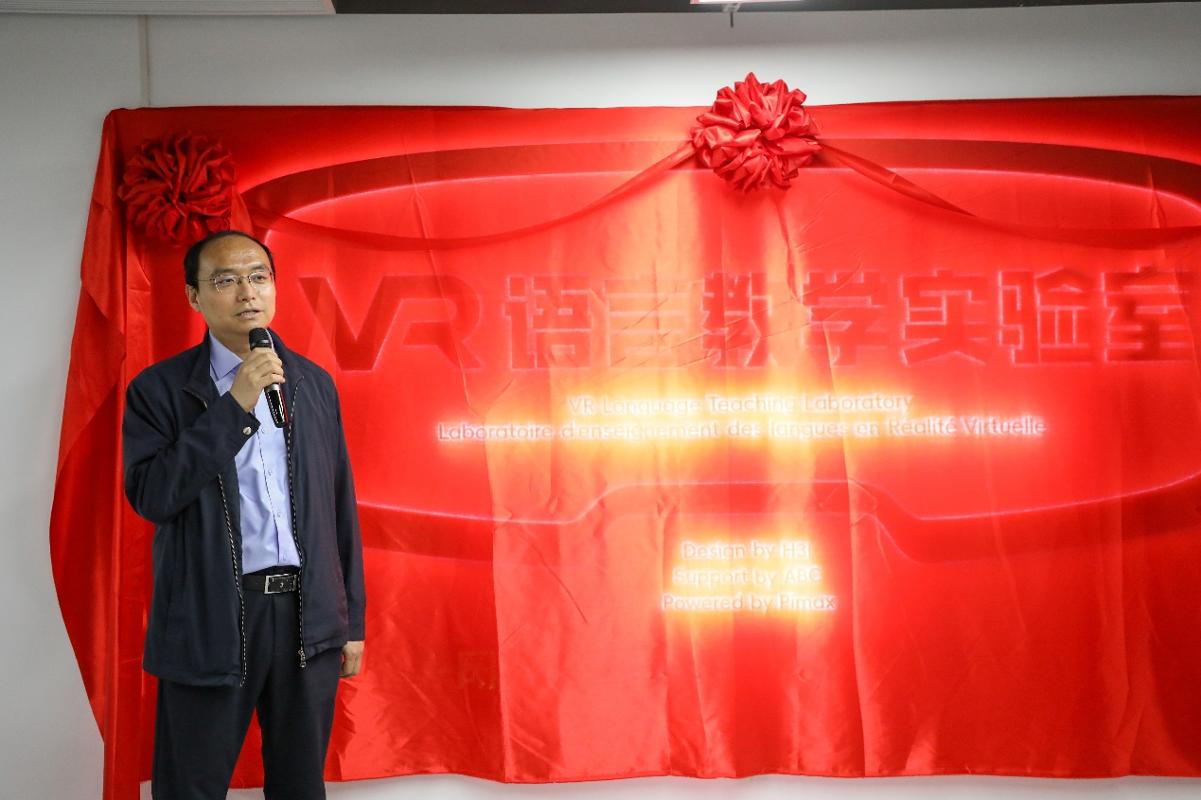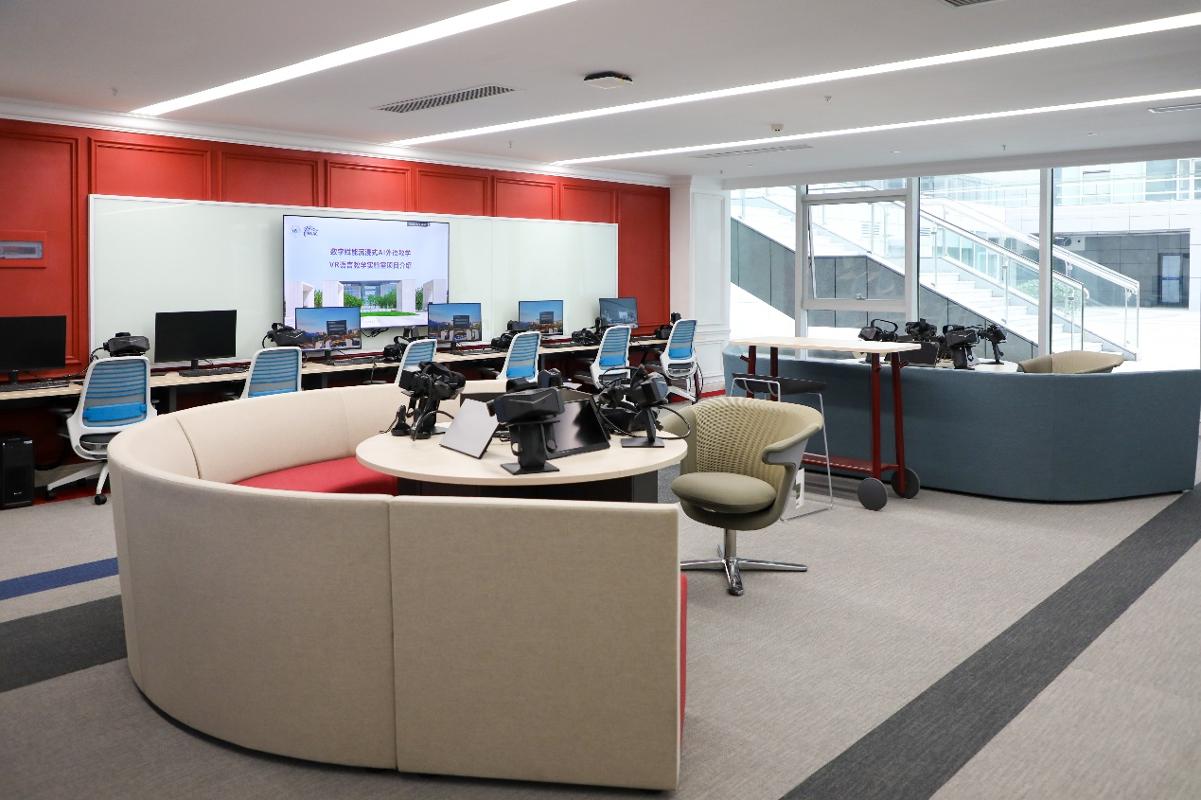(By Zhong Hao, photo by Xie Yuqian) On April 18, the VR Language Teaching Laboratory jointly built by the Hangzhou International Innovation Institute of Beihang University (H3I), the Agricultural Bank of China Hangzhou Branch, and Pimax (Hangzhou) Co., Ltd. was officially inaugurated. This marks the deep integration of artificial intelligence with international education and teaching, and represents another breakthrough in bank-school cooperation. Dong Zhuoning, Director of H3I, and Pan Shaoliang, Party Secretary and President of the Agricultural Bank of China Hangzhou Branch, were invited to attend the ceremony and witness this significant moment.

At the inauguration ceremony, Dong Zhuoning emphasized the significance of establishing the VR Language Teaching Laboratory. He said that the laboratory represents an innovative practice of H3I in digital intelligence-empowered education. By integrating virtual reality technology and language teaching, the laboratory provides students with an immersive and interactive learning experience. It will not only improve teaching efficiency but also support the training of international professionals, thereby injecting new vitality into the nation’s language education endeavors.

During the construction of the laboratory, H3I closely cooperated with the Agricultural Bank of China Hangzhou Branch, fully leveraging the advantages of bank-school cooperation. In his speech, Pan Shaoliang said that as a state-owned bank, the Agricultural Bank of China has been consistently committed to serving society and education. The cooperation with H3I marks a new starting point for collaborative innovation between banks and schools. Agricultural Bank of China will continue to support the digital-intelligent transformation in education. It will ensure the smooth operation and development of the laboratory.

The VR Language Teaching Laboratory is a language learning facility based on immersive virtual reality. To fully utilize the amplifying, additive, and multiplicative effects of digital technology on student education, the laboratory integrates functions such as virtual character dialogue interaction, speech recognition, and real scenario simulation, providing students with a comprehensive and multisensory learning environment. By simulating a real language environment, students can interact and converse with virtual characters in simulated scenarios, thereby continuously improving their foreign language listening and speaking skills and communication abilities in various contexts. The laboratory can be applied to teaching scenarios for French, English, and Chinese as a foreign language.


Anne COURNAULT, Head of the VR Language Teaching Laboratory, said that the project aimed to create a teaching model that combines education with recreation. By introducing the “game” mechanism, students are immersed in a virtual reality environment, as if they were truly in France. In this virtual setting, students are required to use French for oral interaction throughout the process to complete designated tasks. Teachers can track students’ progress flexibly through the teacher interface, ascertain learning difficulties, and improve teaching efficiency. This interactive teaching tool not only implements the prevailing action-oriented teaching method but also reflects the teacher team’s exploratory spirit in actively integrating IT-based teaching methods. Compared with traditional teaching methods, this innovative approach can significantly extend the duration of personalized oral training and greatly improve students’ French speaking abilities. In addition, the application of virtual reality technology helps students consolidate their language knowledge through real-life simulations, while improving their cross-cultural communication competence and situational adaptability.


The students put on all-black, semi-enclosed VR headsets and greeted the “French staff” at the virtual airport. Next, they need to complete more than ten tasks, such as French check-in, baggage checking, and flight number confirmation, using the control joystick and voice Q&A. In case of any pronunciation errors during the process, the “French staff,” who are waiting with smiles, will refuse to hand over the boarding pass until the students meet the required standard. A student exclaimed after his first trial on site: “It is so realistic, as if I’m there in person. It provides a wide range of everyday scenes, similar to a native language environment, where you can talk with the staff. It feels like you are communicating with local people in France. It is a good device for practicing spoken French.”

Prior to the inauguration ceremony, the expert acceptance meeting for the laboratory was held. During the meeting, Pimax (Hangzhou) Co., Ltd. gave a detailed report on the construction of the VR language Teaching Laboratory and the production of software and hardware. Ms. Anne COURNAULT, based on the existing content of the first phase, proposed a conceptual framework for the second-phase teaching content. After on-site inquiries, experts concluded that the construction of the laboratory aligns with the current trend of teaching development and that the project outcomes meet the expected results. They also expressed anticipation for the second-phase construction.
The establishment of the VR Language Teaching Laboratory will further propel the innovative development of language teaching and support the training of international and innovative professionals. Moving forward, H3I will continue to deepen school-enterprise cooperation and explore more application scenarios for digital-intelligent education, thereby contributing to the high-quality development of education.

Approved by Dong Zhuoning, Zhang Wei, Xu Ran
Edited by Yuan Xiaohui

